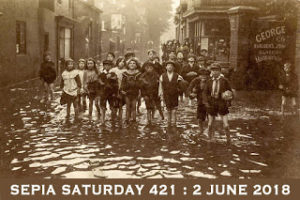 Sepia Saturday provides bloggers with an opportunity to share their history through the medium of photographs.
Sepia Saturday provides bloggers with an opportunity to share their history through the medium of photographs.
Last week, I wrote about the July 1963 Protest at Gwynn Oak Park in Baltimore. Today’s prompt image is useful to tell the rest of the story. If you missed last week’s post, I invite you to take a look.
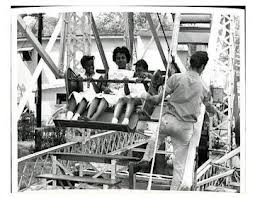 Under pressure to integrate Gwynn Oak Park during the late 1950s and early 1960s, the Price family, owners of the amusement park, claimed that integrating the park would be financially disastrous. But after Gwynn Oak Park integrated on August 28, 1963, the Washington Post ran an article in September with the headline “Gwynn Oak Park Integration Called Financial Success” and reported that the first weekend of September the park earned more money than it did the same weekend the previous year. The transition went smoothly and everyone was seemingly pleased with the outcome.
Under pressure to integrate Gwynn Oak Park during the late 1950s and early 1960s, the Price family, owners of the amusement park, claimed that integrating the park would be financially disastrous. But after Gwynn Oak Park integrated on August 28, 1963, the Washington Post ran an article in September with the headline “Gwynn Oak Park Integration Called Financial Success” and reported that the first weekend of September the park earned more money than it did the same weekend the previous year. The transition went smoothly and everyone was seemingly pleased with the outcome.
Eight years later, however, attendance at the park was down and Gwynn Oak was struggling. The owners blamed their financial problems on integration, but by 1971 the times were changing. More Americans owned cars and society became dominated by the automobile; the trolley lines were gone; and big theme parks like Six Flags were on the rise.
Most of the old trolley parks around the country closed.
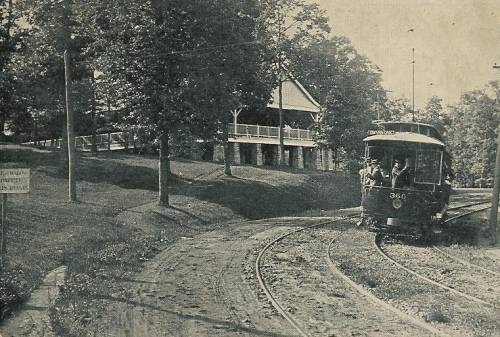
In 1971, the owners of Gwynn Oak took out a loan for half a million dollars, but this wasn’t enough to keep the park afloat and in good repair. In early June 1972, an inspection by county officials found that fourteen of the park’s thirty-nine rides were unsafe.
Just a few weeks later, on June 22, 1972, Hurricane Agnes hit. Agnes was the most destructive hurricane ever recorded up until then and caused terrible flooding and damage in the Baltimore area. Gwynn Oak Park was hit by heavy winds and rain and many of the buildings and rides were destroyed. Hurricane Agnes was the final blow to Gwynn Oak Park.
I found this trailer for a DVD that uses old family footage at the park interspersed with the abandoned ruins.
The county took over the park, which remains open as a picnic and recreation area. Most evidence of the former amusement park is gone. A plaque explains the historical significance of the site.
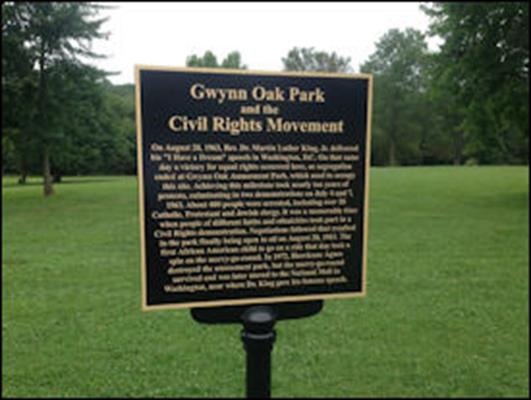
But that is not the end of the story.
Amazingly, the merry-go-round was spared by Hurricane Agnes and was put up for sale.
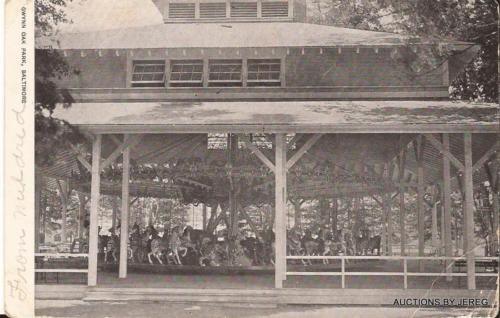
The merry-go-round was purchased by a company that runs concession stands for the Smithsonian. In 1981, Gwynn Oak’s merry-go-round was installed on the National Mall, directly in front of the Smithsonian’s Arts and Industries Building.
Gwynn Oak’s old merry-go-round got a new coat of paint and a new name: the Carousel on the Mall. In 1996 a sea dragon was added to mark the 150th anniversary of the Smithsonian. Later a spinning-tub car was added and the ride’s pipe organ was replaced by a CD player.
The Carousel on the Mall sits within view of the Lincoln Memorial where Rev. Dr. Martin Luther King, Jr. stood on August 28, 1963 and made his “I Have a Dream” speech – on the same day that a black child first rode this merry-go-round in Baltimore, MD.
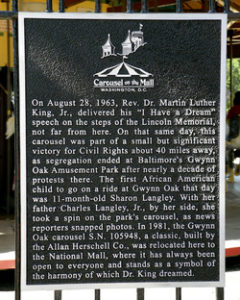

Please visit Sepia Saturday and see how others have interpreted the theme image.
Nathan, A. (2011). Round and Round Together: Taking a Merry-Go-Round Ride into the Civil Rights Movement. Philadelphia: Paul Dry Books.


Ah-ha! I have a picture of that carousel from when I chaperoned a high school history trip in 1992 which included 5 days in Washington D.C. and several trips to the Mall to check out the museums. I remember it feeling rather strange coming up out of the Metro System subway almost directly onto the grass of the Mall and seeing the merry-go-round. Many smaller amusement parks closed their doors in the 1970s. As you say, bigger amusement parks with bigger faster scarier rides were opening up and the smaller parks just couldn’t keep up.
I wondered who would be the first to say they had been there and seen the carousel! You win!
I’ve seen that carousel in person too! Those old parks were never built to last more than a few seasons. Storms always go for the weakest structures too.
I’ve never been there myself. It’s on my list!
Glad the carousel is still around…the video is very sad. Each step in integration should be given its celebration…though there were many backwards ones as well.
Yes – that video is sad. And the eerie music makes it even sadder.
I worked at Gwynn Oak Park from 1960 until its demise in 1973. I felt as if a part of myself went with it because it was so much a part of my life, my world and my identity. I have never been the same since Gwynn Oak Park went away. And when I look at pictures of its destruction, I inevitably feel a sharp pain in the chest, kind of like an arrow through the heart. But what could I do at the time? After working there every season, from the age of 10 to 23, when the park closed its turnstiles in 1974, I took my memories and went home. To this day, I have never recovered from this great loss in my life.
You spent many formative years there, no wonder you feel such a sense of loss. Thank you for your comment.
Thank you for sharing about Gwynn Oak Park. I enjoy learning my biological family’s amusement park. I like reading about the park in its day. I look forward to riding the carousel one day.
Thank you for your comment, Sandy. I hope I did it justice and that you get to ride the carousel. I would like to ride it too! So much history!